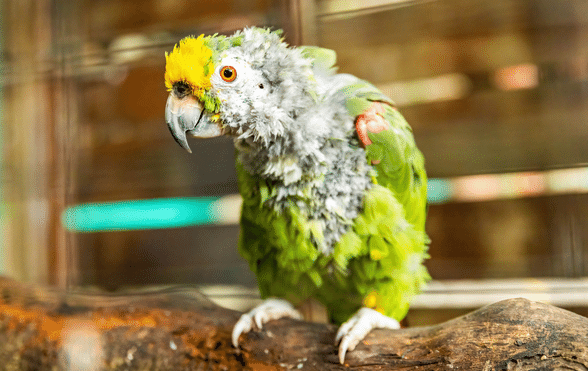A real-life parrot owner writes to expert John Courteney-Smith over feather plucking concerns. Read his response….
Is your parrot insured? Get a quote for up to £5,000 of vet fee cover, death and theft cover | We’ve been insuring exotic pets since 1996 | Check out our customer reviews on Feefo.
Real life question | Risks of placing a bird near a window | The importance of D3 and UV light | Feather plucking in birds for sun exposure | Catching feather plucking early | Water and food | UV lighting
In the concluding part of this series, the practical aspects of using avian lighting are discussed.
What follows here is ‘real life’ question that came in from a concerned bird keeper and, of course, a detailed reply, which links together multiple emails and phone calls.
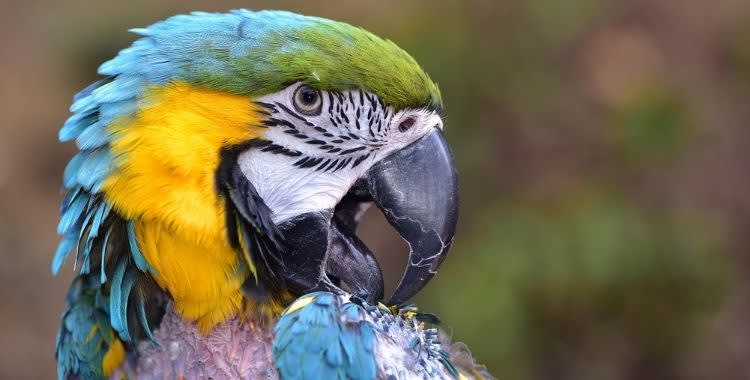
A lack of unfiltered daylight can be linked to feather plucking
The question:
“I have a macaw now over 20 years of age which has been plucking its feathers on and off over the past couple of years.
We moved house at this stage just before it started. The cage has been placed close to a window facing west, and as such, the bird has access to plenty of sunlight. Do you think a full-spectrum light might help to reduce this feather plucking if I put one over the cage?”
The answer
It is vital that we provide ethical and effective care for all of our pets, regardless of species.
As such, the advice of an experienced avian vet must be sought alongside any adjustments to lighting and dietary changes that you choose to make. You can find a vet here.
Diagnostics will be required, being the only way to monitor husbandry changes scientifically.
Also, there are many causes of stress and ill-health in parrots, and these must be worked through, and if possible, eliminated in the search for a solution.
Unfortunately, feather plucking very rarely has a single cause.
A lack of exposure to full-spectrum unfiltered natural daylight is linked with poor feather health, poor quality preening oil and in some cases, feather plucking.
This behaviour can over time, develop into a habit, even if the original cause is corrected.
A lack of access to natural unfiltered daylight is likely to lead to a lack of natural Vitamin D3.
As a result, the assimilation, storage and use of essential earth minerals such as calcium in the body will be adversely affected.
If left untreated over a long period of time, this can ultimately result in Metabolic Bone Disorder, or ‘MBD’.
Although a lack of access to unfiltered natural daylight will not be helping the situation, it may not be the sole cause of the situation with your macaw.
As such, it is vital that the assistance of an experienced avian vet is sought.
Tests will need to be undertaken, followed by treatment if required, for problems such as feather mites.
Cage design and position, the availability of toys and the reduction of any stress factors (or ‘stressors’) that may be affecting your macaw must also be considered.
Stressors impacting on the bird’s life have a very real effect on its overall state of health.
Stress and fear leads in the short term to the release of the hormone cortisol. This is a natural response to stress. However, when the stressors are frequent or protracted, the production of cortisol continues.
The stress factors will negatively impact on your macaw’s health, but so also will cortisol itself, adversely affecting body functions.
Stress is a potential killer and we should do all we can to remove it from our lives, and the lives of our pets.
You can learn more about feather plucking, its causes and treatments here, in our article written by vet expert, Dr. Sophie Bell.
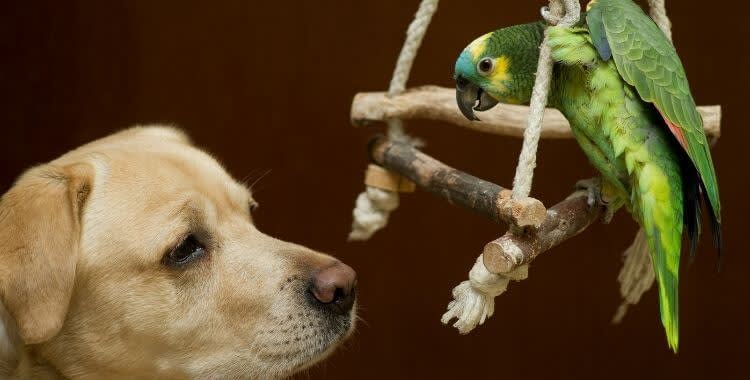
The presence of other pets in close proximity can be stressful to birds.
Risks of placing your bird near a window
Placing a bird close to a window provides a quantity of light (lux) and helps to set natural circadian (day-night) rhythm.
However, you will need to monitor and regulate the temperatures around the cage carefully, because keeping its cage here can be dangerous.
Glass is very good at allowing certain wavelengths of infra-red (IR) through, and greatly increases the risk of serious localised overheating.
This can result in the bird’s death literally within minutes from heat stroke, in the same way that dogs tragically die when left in cars on hot days.
Both are in a restricted environment, which offers no escape to a cooler location.
UV light cannot pass through glass
Almost all forms of glass and plastic are 100 per cent UV-protected.
Placing a bird near a window will not allow it to manufacture vitamin D3 in its body, nor will it enable the bird to utilise its full range of natural avian colour vision.
It brings no benefits and moving your macaw elsewhere in your home is probably a good idea, as the temperature rise could be acting as a stressor.
The importance of D3 and UV light
In terms of vitamin D3 provision, exposing birds of any species to the full-spectrum of an unfiltered terrestrial daylight, or a lamp that replicates the energy, extending from UV-B to IR-B is wholly natural and very beneficial to life.
It is light within the natural wavelengths that birds have developed to utilise in the wild over the course of their evolution.
There are uses for and levels of protection against such energy for avian species generally, within every type of habitat.
Exposure to UV allows the creation of vitamin D3 within the body, known as the D3 cycle.
D3 is not only the catalyst for mineral assimilation, storage and use, but it is also key for maintaining and allowing nerve, brain and vital organ function. It is also used for muscle growth, repair and contraction.
Exposure to UV-A self-regulates the production, storage and recycling of vitamin D3 and activates natural colour vision in the birds highly adapted eyes.
Macaws have evolved to live within and use the high levels of sunlight that occur in their wild habitat.
They are diurnal, being active during the day, spending long periods foraging and flying in the open sky and rainforest.
A characteristic of the group is they have developed bare facial patches essentially devoid of plumage.
This allows these parrots to have easy exposure to sunlight, with the related conures and of course the African grey parrot (Psittacus erithacus) all being similar in this regard.
It suggests their natural requirement for exposure to sunlight is higher than in the case of some other species, as reflected by facial lack of plumage.
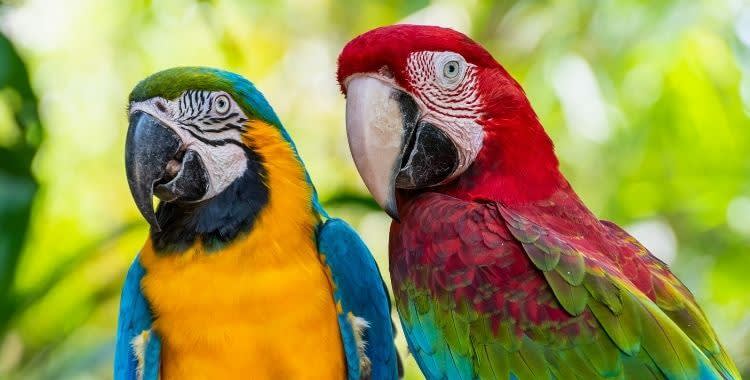
Macaws display an area of bare skin on their faces. the lines of tiny feathers seen here are highly individual, and as distinctive as fingerprints.
Macaws are also known to seek out and consume mineral rich clays. This all points to a group of birds with a high need for vitamin D3 which also require regular doses of minerals.
In balance, these provide for the whole body, from blood to bone and in every single biological process and cycle.
Each species has evolved to require slightly different quantities of energy. Indeed, some species occur in arid and fairly open areas of scrub, whereas others are found in dense jungles.
They use light to provide for the same processes, but in their individual ways.
This means that we have to use the lamps knowingly, in order to provide for each species in the right way, providing energy that is usable by the bird.
Although the sun obviously remains the ultimate provider, quality specialist bird lamps are now very good indeed, being closely matched to the groups of wavelengths that allow for the creation, storage, use and re-cycling of D3, the so-called ‘D3 action spectrum’.
In this way, for those of us who enjoy the benefit of a birdroom, or have a beloved household pet, it means that we have a safe and effective method of providing essential energy from light to both pet birds and breeding stock.
These specialist lamps have been designed to project both the colour and spectrum of light in the most natural way and include adequate levels of UV for their needs.
Feather plucking in birds for sun exposure
If a bird perceives that it has a lack of vitamin D3 and minerals, it may remove feathers in order to expose a greater surface area of skin, for sun exposure.
It is believed that birds do this initially to try and balance the blood chemistry, by increasing their UV-B exposure.
This is core self-preservation: nature causing limited harm in the short term in order to ensure adequate provision over the longer period.
However, if the bird does not have access to UV, it cannot create, store and use D3. This means the body’s mineral stores will become depleted, with those that are ingested passing directly through the body largely unused.
This is the start of the downward spiral into poor physical and mental health that so many parrots and birds have endured over the years.
A chronic lack of vitamin D3 can also instigate a repetitive response if left untreated. As a result, the bird may never recover and feather removal becomes habitual.
There is a solution, however. If terrestrial UV is included over the living space of the bird in a safe and measured way, and the diet is improved, including the provision of natural full spectrum minerals, the bird’s blood chemistry should start to re-balance as D3 levels rise. You can learn how to choose the correct lighting here.
In many cases, a reduction in plucking follows, with feather regrowth then taking place, and in some amazing instances, birds stop plucking forever.
Catching feather plucking early
From my experience, if feather plucking is caught early, with a dedicated full-spectrum+UV-B fluorescent bird lamp being used properly and a natural full-spectrum mineral mix being utilised alongside a calcium and magnesium powder, positive results can be seen fairly quickly. You can learn more about the role of Calcium and Magnesium here.
Once again, a well planned recovery should be undertaken alongside the watchful eye of your vet.
Try to reduce stressors around the bird and spend some time with it to be sure there’s not a nearby predator within eyesight causing distress.
Assess its diet to be sure that it is receiving the correct nutrition, and spray its plumage with water at least twice every day.
This will encourage preening, using oil from the preen gland, and contributes to improved feather health. What is required is healthy preening without plucking.
Water and food
Many keepers do not provide anywhere near enough water, or provide it in the wrong way.
Yes, birds will drink from a water dish, as they will drink from streams and puddles in the wild. But they will also increase their hydration through drinking rain droplets and inhaling water vapour.
Fine misting of their cages, with food pots removed, can be very positive for increasing their hydration and overall plumage health.
Neither pellets nor seed-only diets are recommended, but both can be used to help create a full and varied wild-type diet, when supplemented with fresh fruits and vegetables, which also have a valuable water content. Learn what parrots can eat here.
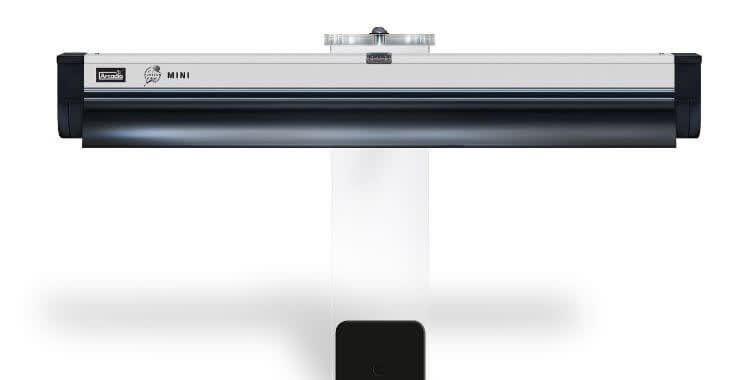
Suitable lighting and fitments are available for birds of all sizes
UV Lighting
Aim to provide full spectrum+UV-B bird lighting for a photoperiod (interval) each day, offering 10-12 hours of illumination.
Seasonality can be factored in if required of course, especially for breeding birds. Choose a lamp that is able to provide for the needs of your species and note the distance the lamp must be fitted safely above the bird – typically 30-38cm (12-15in) above the bird’s head when it is seated on the topmost perch.
For your macaw, you will need a 54W HO-T5 Bird lamp and ProT5 fitting. This will provide a wide area of light, which will cover the whole bird while still allowing a natural provision of shade around the cage for self-regulation.
Lamp guards can be purchased to help negate damage to the lamp and fitting and to protect the bird from harm.
Choose lamp technology that is digital, which will ensure that the lamp is producing light that is flicker-free.
Change UV producing bird lamps as per the manufacturer’s’ advice: typically once every 12 months to be sure of optimal UV output in the case of Arcadia lamps. You can learn more about the correct lighting for your bird here.
This approach, set alongside safe and managed access to natural daylight outside in the garden when it is warm enough, will help to provide for your bird.
Your vet will monitor D3 and calcium levels through blood testing, and once this system is in place, these should start to increase.
As this occurs, the feather plucking will hopefully decline, and could disappear totally.
During his time helping keepers with using quality full-spectrum+UV-B bird lighting, in combination with better feeding of their birds, John Courtney-Smith has documented a welcomed improvement in roughly eight in ten cases of feather-plucking, although the earlier that you start, the better will be the chances of overcoming this problem totally.
More articles from the UV lighting series:
Read: The importance of UV lighting for birds – part one.
Read: The benefits of UV lighting for birds – part two.
Read: Calcium, Magnesium and UV, preventing feather plucking in birds – part three.
Read: How to choose the correct lighting for your bird – part four.
Is your parrot insured? Get a quote for up to £5,000 of vet fee cover, death and theft cover | We’ve been insuring exotic pets since 1996 | Check out our customer reviews on Feefo.
John Courteney-Smith MRSB FLS is Head of Science and Innovation at Arcadia Reptile and David Alderton is an expert in reptile and pet care.
This article has been reproduced for Exotic Direct with the kind permission of John Courteney-Smith MRSB FLS, in conjunction with David Alderton. Many thanks for their support.
The content is owned by John Courteney-Smith MRSB FLS and cannot be reproduced without his permission.

